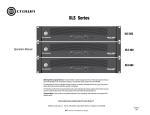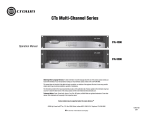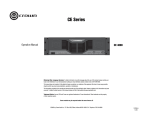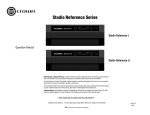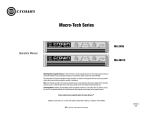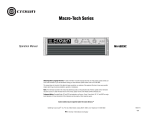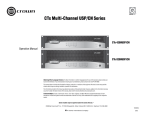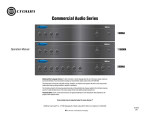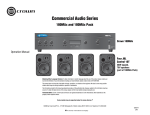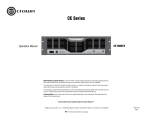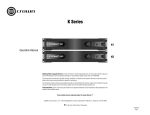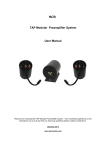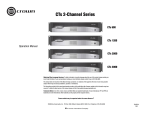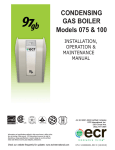Download Crown CTs Series Instruction manual
Transcript
CTs 2-Channel Series CTs 600 CTs 1200 Operation Manual CTs 2000 CTs 3000 Obtaining Other Language Versions: To obtain information in another language about the use of this product, please contact your local Crown Distributor. If you need assistance locating your local distributor, please contact Crown at 574-294-8000. This manual does not include all of the details of design, production, or variations of the equipment. Nor does it cover every possible situation which may arise during installation, operation or maintenance. The information provided in this manual was deemed accurate as of the publication date. However, updates to this information may have occurred. To obtain the latest version of this manual, please visit the Crown website at www.crownaudio.com. Trademark Notice: Com-Tech, Crown, Amcron and Multi-Mode are registered trademarks of Crown International. PIP and PIP2 are trademarks of Crown International. Other trademarks are the property of their respective owners. Some models may be exported under the name Amcron.® ©2002 by Crown Audio, Inc. P.O. Box 1000, Elkhart, Indiana 46515-1000 U.S.A. Telephone: 574-294-8000 134433-3 10/02 CTs 2-Channel Power Amplifiers Important Safety Instructions 1) 2) 3) 4) 5) 6) 7) 8) 9) 10) 11) 12) 13) 14) 15) page 2 Read these instructions. Keep these instructions. Heed all warnings. Follow all instructions. Do not use this apparatus near water. Clean only with a dry cloth. Do not block any ventilation openings. Install in accordance with the manufacturer’s instructions. Do not install near any heat sources such as radiators, heat registers, stoves, or other apparatus that produce heat. Do not defeat the safety purpose of the polarized or grounding-type plug. A polarized plug has two blades with one wider than the other. A grounding-type plug has two blades and a third grounding prong. The wide blade or the third prong is provided for your safety. If the provided plug does not fit into your outlet, consult an electrician for replacement of the obsolete outlet. Protect the power cord from being walked on or pinched, particularly at plugs, convenience receptacles, and the point where they exit from the apparatus. Only use attachments/accessories specified by the manufacturer. Use only with a cart, stand, bracket, or table specified by the manufacturer, or sold with the apparatus. When a cart is used, use caution when moving the cart/apparatus combination to avoid injury from tip-over. Unplug this apparatus during lightning storms or when unused for long periods of time. Refer all servicing to qualified service personnel. Servicing is required when the apparatus has been damaged in any way, such as powersupply cord or plug is damaged, liquid has been spilled or objects have fallen into the apparatus, the apparatus has been exposed to rain or moisture, does not operate normally, or has been dropped. To reduce the risk of fire or electric shock, do not expose this apparatus to rain or moisture. TO PREVENT ELECTRIC SHOCK DO NOT REMOVE TOP OR BOTTOM COVERS. NO USER SERVICEABLE PARTS INSIDE. REFER SERVICING TO QUALIFIED SERVICE PERSONNEL. À PRÉVENIR LE CHOC ÉLECTRIQUE N’ENLEVEZ PAS LES COUVERCLES. IL N’Y A PAS DES PARTIES SERVICEABLE À L’INTÉRIEUR. TOUS REPARATIONS DOIT ETRE FAIRE PAR PERSONNEL QUALIFIÉ SEULMENT. IMPORTANT CTs Series amplifiers require Class 2 output wiring. MAGNETIC FIELD CAUTION! Do not locate sensitive high-gain equipment such as preamplifiers or tape decks directly above or below the unit. Because this amplifier has a high power density, it has a strong magnetic field which can induce hum into unshielded devices that are located nearby. The field is strongest just above and below the unit. If an equipment rack is used, we recommend locating the amplifier(s) in the bottom of the rack and the preamplifier or other sensitive equipment at the top. WATCH FOR THESE SYMBOLS: The lightning bolt triangle is used to alert the user to the risk of electric shock. The exclamation point triangle is used to alert the user to important operating or maintenance instructions. FCC COMPLIANCE NOTICE This device complies with part 15 of the FCC rules. Operation is subject to the following two conditions: (1) This device may not cause harmful interference, and (2) this device must accept any interference received, including interference that may cause undesired operation. CAUTION: Changes or modifications not expressly approved by the party responsible for complicance could void the user’s authority to operate the euqipment. NOTE: This equipment has been tested and found to comply with the limits for a Class B digital device, pursuant to part 15 of the FCC Rules. These limits are designed to provide reasonable protection against harmful interference in a residential installation. This equipment generates, uses, and can radiate radio frequency energy and, if not installed and used in accordance with the instruction manual, may cause harmful interference to radio communications. However, there is no guarantee that interference will not occur in a particular installation. If this equipment does cause harmful interference to radio or television reception, which can be determined by turning the equipment off and on, the user is encouraged to try to correct the interference by one or more of the following measures: • Reorient or relocate the receiving antenna. • Increase the separation between the equipment and receiver. • Connect the equipment into an outlet on a circuit different from that to which the receiver is connected. • Consult the dealer or an experienced radio/TV technician for help. Operation Manual CTs 2-Channel Power Amplifiers Table of Contents Important Safety Instructions .......................................................... 2 5.1.4 High-Pass Filters ......................................................14 Table of Contents ........................................................................... 3 5.1.5 Low-Pass Filters .......................................................14 1 Welcome ....................................................... 4 5.1.6 AC Under/Over Voltage Protection ............................14 1.1 Features ............................................................................. 4 5.1.7 Circuit Breaker ..........................................................14 2 How to Use This Manual .................................... 5 5.1.8 DC Output Servo .......................................................14 3 Setup ........................................................... 6 5.1.9 Inrush Limiting ..........................................................14 3.1 Unpack Your Amplifier ....................................................... 6 5.1.10 Variable-speed Fans ................................................14 3.2 Install Your Amplifier ......................................................... 6 5.2 Advanced Features .............................................................14 3.3 Ensure Proper Cooling ....................................................... 6 5.2.1 Switching Power Supply ...........................................14 3.4 Choose Input Wire and Connectors .................................... 7 5.2.2 Input Compressor .....................................................14 3.5 Choose Output Wire and Connectors ................................. 7 5.2.3 Sleep Circuit ..............................................................14 3.6 Wire Your System .............................................................. 8 5.2.4 Input Sensitivity Switches .........................................15 3.6.1 Dual 8/4/2 Mode ....................................................... 8 5.3 Options ..............................................................................15 3.6.2 Bridge-Mono 16/8/4 Mode ........................................ 8 5.3.1 Channel Level Control ...............................................16 3.6.3 Dual 70V/100V Mode ................................................ 9 6 Troubleshooting...............................................17 3.6.4 Bridge-Mono 140V/200V Mode ................................ 9 7 Specifications .................................................19 3.6.5 Dual Mode with “Y” Input .......................................... 10 8 AC Power Draw and Thermal Dissipation .................23 3.7 Connect to AC Mains ......................................................... 11 9 Service .........................................................26 3.8 Startup Procedure .............................................................. 11 9.1 Worldwide Service .............................................................26 4 Operation ...................................................... 11 9.2 US and Canada Service.......................................................26 4.1 Precautions ........................................................................ 11 9.2.1 Service at a US or Canada Service Center .................26 4.2 Front Panel Controls and Indicators ................................... 12 9.2.2 Factory Service .........................................................26 4.3 Back Panel Controls and Connectors ................................. 13 9.2.3 Factory Service Shipping Instructions .......................26 5 Advanced Features and Options ...........................14 9.2.4 Crown’s Profit Protection Plan ...................................26 5.1 Protection Systems ............................................................14 10 Warranty ......................................................27 5.1.1 Thermal Level Control (TLC) .....................................14 Crown Factory Service Information Form .......................................29 5.1.2 Junction Temperature Simulation (JTS) .....................14 Declaration of Conformity ..............................................................31 5.1.3 Fault ..........................................................................14 Operation Manual page 3 CTs 2-Channel Power Amplifiers CTs 600 2-ohm Dual (per ch.) 4-ohm Dual (per ch.) 8-ohm Dual (per ch.) 16-ohm Dual (per ch.) 70V Dual (per ch.) 4-ohm Bridge 8-ohm Bridge 16-ohm Bridge 140V Bridge * 20 Hz–20 kHz Power 150W 300W 300W 300W 300W 300W 600W 600W 600W *20 Hz–20 kHz Power: refers to maximum average power in watts from 20 Hz to 20 kHz with 0.1% THD. CTs 1200 2-ohm Dual (per ch.) 4-ohm Dual (per ch.) 8-ohm Dual (per ch.) 16-ohm Dual (per ch.) 70V Dual (per ch.) 4-ohm Bridge 8-ohm Bridge 16-ohm Bridge 140V Bridge * 20 Hz–20 kHz Power 250W 600W 600W 300W 600W 500W 1200W 1200W 1200W *20 Hz–20 kHz Power: refers to maximum average power in watts from 20 Hz to 20 kHz with 0.1% THD. page 4 CTs 2000 2-ohm Dual (per ch.) 4-ohm Dual (per ch.) 8-ohm Dual (per ch.) 16-ohm Dual (per ch.) 70V Dual (per ch.) 100V Dual (per ch.) 4-ohm Bridge 8-ohm Bridge 16-ohm Bridge 140V Bridge 200V Bridge 1 Welcome Building on the foundation of the Com-Tech ® Series, Crown's CTs Series offers new flexibility and value for installed sound. The Com-Tech Series was the first to offer independent selection of high- and low-impedance operation for a specific channel, and CTs Series amplifiers continue that tradition, with power levels and features carefully chosen to perfectly integrate into fixed install design requirements. Modern power amplifiers are sophisticated pieces of engineering capable of producing extremely high power levels. They must be treated with respect and correctly installed if they are to provide the many years of reliable service for which they were designed. In addition, CTs Series amplifiers include a number of features which require some explanation before they can be used to their maximum advantage. • Direct constant-voltage (70V/100V/140V/200V) or low-impedance (2/4/8 ohm) operation. • Input sensitivity is independently selectable for each channel. Choose low-impedance (4/8 ohm), constant-voltage (70V/ 100V/140V/200V), or 26 dB. • TLC protection circuitry protects the amplifier from long-term excessive heat by subtly and dynamically reducing the gain only when necessary. • JTS circuitry (CTs 600/1200 only) quickly protects BJT output transistors from unsafe operating conditions without shutting the channel down. (BCA amplifiers don’t need JTS as they are inherently protected.) • P I P 2 ™ (Programmable Input Processor) connector accepts accessory modules that tailor the amplifier to suit specific applications. • Removable terminal block input connectors, with “Y” Input Switch in the standard PIP2-BBY module. Please take the time to study this manual so that you can obtain the best possible service from your amplifier. 1.1 Features • Switching Power Supply for reduced weight. • High power-density, with all two-channel models in a 2U chassis. (Continued on next page) * 20 Hz–20 kHz Power 1000W 1000W 1000W 625W 1000W 1000W 2000W 2000W 2000W 2000W 2000W *20 Hz–20 kHz Power: refers to maximum average power in watts from 20 Hz to 20 kHz with 0.35% THD. CTs 3000 2-ohm Dual (per ch.) 4-ohm Dual (per ch.) 8-ohm Dual (per ch.) 16-ohm Dual (per ch.) 70V Dual (per ch.) 100V Dual (per ch.) 4-ohm Bridge 8-ohm Bridge 16-ohm Bridge 100V Bridge 200V Bridge * 20 Hz–20 kHz Power 1500W 1500W 1250W 625W 1500W 1500W 3000W 3000W 2500W 3000W 3000W *20 Hz–20 kHz Power: refers to maximum average power in watts from 20 Hz to 20 kHz with 0.35% THD. Operation Manual CTs 2-Channel Power Amplifiers 1 Welcome • • • • Operation Manual Features (continued from page 4) • Switchable high-pass filter for each channel provides low-frequency roll off to eliminate step down transformer saturation when used in distributed systems. Legendary Crown class I (BCA) and class AB+B (Multi-Mode ®) output topologies offer the best in amplifier reliability. CTs 600/1200 use Class AB+B; CTs 2000/ 3000 use Class I. • Class I is the lowest distortion, lowest noise, and highest performing topology available among switch-mode amplifiers. • Continuously-variable fans optimize cooling efficiency. • Three Year, No-Fault, Fully-Transferable Warranty completely protects your investment and guarantees its specifications. • Crown’s Profit Protection Plan guarantees replacement of covered amps should they fail at any time during the original threeyear warranty period (available in U.S. only). Comprehensive array of indicators including Power, Data, and Bridge; along with Ready, Signal, Clip, Thermal and Fault for each channel, provide accurate diagnostics. Blue Power Indicator flashes if the amplifier shuts off due to an under/over-voltage condition on the AC mains. Advanced protection circuitry guards against: shorted outputs, DC, mismatched loads, general overheating, under-/overvoltage, high-frequency overloads and internal faults. 2 How to Use This Manual This manual provides you with the necessary information to safely and correctly setup and operate your amplifier. It does not cover every aspect of installation, setup or operation that might occur under every condition. For additional information, please consult Crown’s Amplifier Application Guide (available online at www.crownaudio.com), Crown Tech Support, your system installer or retailer. We strongly recommend you read all instructions, warnings and cautions contained in this manual. Also, for your protection, please send in your warranty registration card today. And save your bill of sale—it’s your official proof of purchase. page 5 CTs 2-Channel Power Amplifiers 3 Setup 3.1 Unpack Your Amplifier Please unpack and inspect your amplifier for any damage that may have occurred during transit. If damage is found, notify the transportation company immediately. Only you can initiate a claim for shipping damage. Crown will be happy to help as needed. Save the shipping carton as evidence of damage for the shipper’s inspection. We also recommend that you save all packing materials so you will have them if you ever need to transport the unit. Never ship the unit without the factory pack. YOU WILL NEED (not supplied): • Input wiring cables • Output wiring cables 3.2 Install Your Amplifier CAUTION: Before you begin, make sure your amplifier is disconnected from the power source, with power switch in the “off” position and all level controls turned completely down (counterclockwise). Use a standard 19-inch (48.3 cm) equipment rack. See Figure 3.1 for amplifier dimensions. You may also stack amps without using a cabinet. 3.3 Ensure Proper Cooling When using an equipment rack, mount units directly on top of each other. Close any open spaces in rack with blank panels. DO NOT block front or rear air vents. The side walls of the rack should be a minimum of two inches (5.1 cm) away from the amplifier sides, and the back of the rack should be a minimum of four inches (10.2 cm) from the amplifier back panel. Figure 3.2 illustrates standard amplifier airflow. NOTE: When transporting, amplifiers should be supported at both front and back. Rack for mounting amplifier (or a stable surface for stacking) WARNING: Before you start to set up your amplifier, make sure you read and observe the Important Safety Instructions found at the beginning of this manual. Figure 3.2 Airflow FRONT Figure 3.1 CTS 2-Channel Series Dimensions page 6 Operation Manual CTs 2-Channel Power Amplifiers 3 Setup 3.4 Choose Input Wire and Connectors Figure 3.3 shows connector pin assignments for balanced wiring, and Figure 3.4 shows connector pin assignments for unbalanced wiring. Figure 3.3 Balanced Input Connector Wiring NOTE: Custom wiring should only be performed by qualified personnel. Figure 3.4 Unbalanced Input Connector Wiring 3.5 Choose Output Wire and Connectors Crown recommends using professionally constructed, high-quality, two- or four-conductor, heavy gauge speaker wire and connectors. You may use terminal forks up to 10 AWG or bare wire for your output connectors (see Figure 3.5). To prevent the possibility of short-circuits, wrap or otherwise insulate exposed loudspeaker cable connectors. For best results, Crown recommends Panduit part #PV10-10LF-L or equivalent terminal fork. Screw spacing is shown in Figure 3.5. Using the guidelines below, select the appropriate size of wire based on the distance from amplifier to speaker (low-impedance loads only). Distance Wire Size up to 25 ft. (7.6m) 16 AWG 26-40 ft. (7.9-12.2m) 14 AWG 41-60 ft. (12.5-18.3m) 12 AWG > 60 ft (18.3m) 10 AWG Figure 3.5 Typical Output Connector Wiring CAUTION: Never use shielded cable for output wiring. Replace output cover after output wiring is complete. Operation Manual page 7 CTs 2-Channel Power Amplifiers 3 Setup 3.6 Wire Your System 3.6.1 Dual 8/4/2 Mode Typical input and output wiring, along with Attenuator and Mode Switch settings are shown in Figures 3.6 and 3.7. Make sure the Mode switch is set to the “Dual” position when operating in Dual mode. INPUTS: Connect input wiring for each channel. The Y switch on the rear PIP panel can be used to parallel the channel inputs when only mono input signals are necessary. The amplifier’s channel outputs are still independent. OUTPUTS: Maintain proper polarity (+/–) on output connectors. Figure 3.7 Attenuator and ModeSwitch Settings for Dual Mode Connect the Channel 1 speaker’s positive (+) lead to amplifier Channel 1 positive terminal; repeat for negative (–). Repeat Channel-2 wiring as for Channel 1. Refer to Section 3.5 for output connector pin assignments. Figure 3.6 System Wiring, Dual Mode. 3.6.2 Bridge-Mono 16/8/4 Mode Typical input and output wiring, along with Attenuator and Mode Switch settings, are shown in Figures 3.8 and 3.9. Make sure the Mode switch is set to the “Mono” position when operating in Bridge-Mono mode. Always route the input and output wires in separate bundles. INPUTS: Connect input wiring to Channel 1 only. OUTPUTS: Connect the speaker across the positive terminals of each channel pair. Do not use the negative terminals of the channel pair when the pair is being operated in Bridge-Mono mode. Refer to Section 3.5 for output connector pin assignments. NOTE: Crown provides a reference of wiring pin assignments for commonly used connector types in the Crown Amplifier Application Guide available at www.crownaudio.com. NOTE: When operating in Bridge-Mono mode, turn down (full CCW) the Input Attenuator for Channel 2. The Channel-1 Input Atttenuator works both channels. Figure 3.9 Attenuator and ModeSwitch Settings for Bridge-Mono Mode See the next page for constant-voltage operation. Figure 3.8 System Wiring, Bridge-Mono Mode page 8 Operation Manual CTs 2-Channel Power Amplifiers 3 Setup 3.6.3 Dual 70V/100V Mode Typical input and output wiring, along with Attenuator and Mode Switch settings are shown in Figures 3.10 and 3.11. Make sure the Mode switch is set to the “Dual” position when operating in Dual mode. INPUTS: Connect input wiring to both channels. OUTPUTS: In Dual Mode, the CTs 600/1200 can power 25/50/70V lines; the CTs 2000/3000 can power 25/50/70/100V lines. Connect each channel of output connectors to speakers that have the appropriate transformers. Figure 3.11 Attenuator and Mode-Switch Settings for 70V/100V Operation . Figure 3.10 System Wiring and Y-Switch Setting for 70V/100V Operation Always route the input and output wires in separate bundles. 3.6.4 Bridge-Mono 140V/200V Mode Typical input and output wiring, along with Attenuator and Mode Switch settings are shown in Figures 3.12 and 3.13. Make sure the Mode switch is set to the “Mono” position when operating in Bridge-Mono mode. INPUTS: Connect input wiring to Channel 1 only. OUTPUTS: In Bridge-Mono mode, the CTs 600/ 1200 can power 140V lines; the CTs 2000/3000 can power 140V and 200V lines. Connect speakers with 140V or 200V transformers across the positive terminals of the channel pair. Do not use the negative terminals of the channel pair when the pair is being operated in Bridge-Mono mode. Refer to Section 3.5 for output connector pin assignments. Figure 3.13 Attenuator and Mode-Switch Settings for 140V/200V Operation NOTE: When operating in Bridge-Mono mode, turn down (full CCW) the Input Attenuator for Channel 2. The Channel-1 Input Attenuator works both channels. Figure 3.12 System Wiring and Y-Switch Setting for 140V/200V Operation Operation Manual page 9 CTs 2-Channel Power Amplifiers 3 Setup 3.6.5 Dual Mode with “Y” Input See Figure 3.14. This configuration feeds a mono signal to both Channel 1 and Channel 2. In the example in Figure 3.14, Channel 1 is driving a lowimpedance loudspeaker and Channel 2 is driving a loudspeaker with a 70V transformer. INPUTS: Connect the signal to the Channel 1 input. On the back panel, set the “Y” Input Switch to ON. OUTPUTS: Connect the Channel 1 speaker’s positive (+) lead to Channel 1 positive terminal of amp; repeat for negative (–). Connect the Channel 2 speaker’s positive (+) lead to Channel 2 positive terminal of amp; repeat for negative (–). See Figure 3.15. Turn up both Input Attenuators and set the Mode Switch to Dual. NOTE: When the “Y” Input Switch is on, the Channel 2 input can be used to daisy-chain to another amplifier. Figure 3.14 System Wiring for “Y” Input Mode Always route the input and output wires in separate bundles. Figure 3.15 Attenuator and Mode-Switch Settings for “Y” Input Mode page 10 Operation Manual CTs 2-Channel Power Amplifiers 3 Setup 3.7 Connect to AC Mains On the back panel, check whether your amplifier is labeled for 120V or 220-240V AC mains. Connect your amplifier to the corresponding AC mains power source (power outlet) with the supplied AC power cordset. First, connect the IEC end of the cordset to the IEC connector on the amplifier. Then, with the amplifier in the OFF position, plug the other end of the cordset into the AC mains. WARNING: The third prong of this connector (ground) is an important safety feature. Do not attempt to disable this ground connection by using an adapter or other methods. Amplifiers don’t create energy. The AC mains voltage and current must be sufficient to deliver the power you expect. Check the amplifier’s back-panel label which specifies the required AC mains voltage and frequency. The AC mains voltage must be no more than 15% above the required voltage, and no less than 25% below the required voltage. The AC mains frequency must be within the required frequency range. If you are unsure of the output voltage of your AC mains, please consult your electrician. 3.8 Startup Procedure Use the following procedure when first turning on your amplifier: 4 Operation 4.1 Precautions Your amplifier is protected from internal and external faults, but you should still take the following precautions for optimum performance and safety: 1. Before use, your amplifier first must be configured for proper operation, including input and output wiring hookup. Improper wiring can result in serious operating difficulties. For information on wiring and configuration, please consult the Setup section of this manual or, for advanced setup techniques, consult Crown’s Amplifier Application Guide available online at www.crownaudio.com. 2. Use care when making connections, selecting signal sources and controlling the output level. The load you save may be your own! 3. Do not short the ground lead of an output cable to the input signal ground. This may form a ground loop and cause oscillations. 4. Never connect the output to a power supply, battery or power main. Electrical shock may result. 2. Turn down the level controls of the amplifier. 5. Tampering with the circuitry, or making unauthorized circuit changes may be hazardous and invalidates all agency listings. 3. Turn on the “Power” switch. The Power indicator should glow. Wait for the “Ready” LED to illuminate. 6. Do not operate the amplifier with the red Clip LEDs constantly flashing. 4. Turn up the level of your audio source to an optimum level. 7. Do not overdrive the mixer, which will cause clipped signal to be sent to the amplifier. Such signals will be reproduced with extreme accuracy, and loudspeaker damage may result. 1. Turn down the level of your audio source. 5. Turn up the Level controls on the amplifier until the desired loudness or power level is achieved. Verify that the Signal LED is flashing. 6. Turn down the level of your audio source to its normal range. If you ever need to make any wiring or installation changes, don’t forget to turn off the amplifier and disconnect the power cord. 8. Do not operate the amplifier with less than the rated load impedance. Due to the amplifier’s output protection, such a configuration may result in premature clipping and speaker damage. Remember: Crown is not liable for damage that results from overdriving other system components. For help with determining your system’s optimum gain structure (signal levels) please refer to the Crown Amplifier Application Guide, available online at www.crownaudio.com. Operation Manual page 11 CTs 2-Channel Power Amplifiers 4 Operation 4.2 Front Panel Controls and Indicators A. Fault Indicator Red LED, one per channel, flashes when the amplifier output channel has stopped operating. Usually this means that the amplifier must be serviced. B. Thermal Indicator Red LED, one per channel, illuminates when the channel has shut down, or is very near shutting down, due to thermal stress or overload. C. Ready Indicator Green LED, one per channel, illuminates when the channel is initialized and ready to produce audio output. Indicator is off when the channel is set to standby mode via the IQ system. Signal Indicators Three green LEDS per channel indicate the amplifier’s input and output signal levels. From bottom to top the LEDs are: D. Signal: input signal is above –40 dBu. E. –20 dB: amplifier output is within 20 dB of clipping. F. –10 dB: amplifier output is within 10 dB of clipping. I. Power Indicator Blue LED indicates AC power has been applied and is within the safe operating range of the power supply. The LED will flash when the AC line voltage is approximately 15% above or 25% below the nominal rated value. J. Data Indicator Yellow LED indicates IQ Loop data activity This LED is driven by the IQ-PIP2 module via the PIP2 interface. Note: Data indicator flashes only when the installed PIP module is polled for data, or is polled to see whether it is online. G. Clip Indicator Red LED, one per channel, illuminates when the channel’s output signal reaches the onset of audible clipping. The Clip Indicator also will illuminate during Thermal Level Control (TLC) limiting or when the input compressor/limiter is protecting the amplifier from input overload. K. Bridge Mode Indicator Yellow LED illuminates when the rearpanel Mode Switch is set to the “Bridge” position H. Cooling Vents Front-to-rear forced airflow. L. Power Switch Push-on / push-off switch. Figure 4.1 CTs 600 front panel. page 12 Operation Manual CTs 2-Channel Power Amplifiers 4 Operation 4.3 Back Panel Controls and Connectors. CTs 2000/3000 back panel is shown. CTs 600/1200 look slightly different near the Reset button. M. Power Cord Connector Standard 15 amp IEC inlet. A circuit breaker located near the IEC power inlet protects the amplifier from excessive AC current draw. N. Reset Switch Resets the circuit breaker that protects the power supply. O. Ventilation Grille Air flow is front to back. Do not block the ventilation grilles. P. PIP ™ Input Panel PIP2-BBY module includes two balanced 3-pin removable barrier connectors. The “Y” Input Switch is described under letter R. Sensitivity Switches Behind the input panel are the Input Sensitivity Switches. One 3-position switch per channel selects various sensitivity settings. See Section 5.2.4 for details and diagram. Q. Mode Switch This two-position switch is used to select the amplifier’s mode of operation: Dual or Bridge Mono. Dual mode is used for 2/4/8 ohms, for 70V operation with the CTs 600/1200, and for 70/100V operation with the CTs 2000/ 3000. Bridge mode is used for 4/8/16 ohms, for 140V operation with the CTs 600/1200, and for 100/140/200V operation with the CTs 2000/3000. R. “Y” Input Switch When set to ON, this switch parallels the input signals of the two channels, for use when the input signal is mono. The amplifier’s channel outputs are still independent. The “Y” Input Switch also can be used to daisy-chain the signal to another amplifier. See Section 3.6.5 for details. S. Input Connectors Balanced 3-pin terminal block connectors, one per channel. T. Channel Level Controls One 21-position detented rotary attenuator per channel, ranging from –100 dB to 0 dB gain. U. High-Pass Filter One 3-position switch per channel selects between OFF, 35Hz and 70Hz 3rd-order filters. V. Speaker Connectors One four-pole touch-proof terminal strip. Accepts up to 10 AWG terminal forks. Output Cover (not shown) This covers the output connectors, protecting users from the connectors’ potentially high voltage. This cover is required for Class 2 wiring installations. Figure 4.2 CTs 2000 and 3000 Back Panel Controls and Connectors Operation Manual page 13 CTs 2-Channel Power Amplifiers 5 Advanced Features and Options NOTE: For detailed information about these Crown amplifier features, please consult the Crown Amplifier Application Guide, available on the Crown website at www.crownaudio.com 5.1.3 Fault The amplifier will light the Fault LED if the amplifier output stage stops operating. If this happens, see Section 8 for servicing information. 5.1 Protection Systems Your Crown amplifier provides extensive protection and diagnostic capabilities, including thermal level control, fault indicators, highpass filtering, DC protect, AC under/over voltage protection, inrush limiting, and variablespeed fans. 5.1.4 High-Pass Filters Very low frequency signals contain no useful musical energy, waste valuable amplifier power and headroom, and can be damaging to your speakers. Your Crown amplifier provides highpass filters to remove these signals from each channel’s output. 5.1.1 Thermal Level Control (TLC) If the amplifier becomes too hot for safe operation, the light will shine brightly and TLC will engage the input compressor. By compressing the input, the amplifier will not generate as much heat and will have a chance to cool down. The degree of compression is proportional to the amount of overheating. This feature allows the show to go on, rather than having the amplifier shut down. On the back panel are two 3-position 3rd-order high-pass filter switches (one per channel) with selections of Off, 35Hz and 70 Hz. 5.1.2 Junction Temperature Simulation (JTS) (CTs 600/1200 only) JTS circuitry simulates the operation of the amplifier’s output transistors, and compares it against the transistors known Safe Operation Area (SOA). If JTS sees that more power is about to be asked of the output devices than they are capable of delivering under the present conditions, JTS immediately limits the drive level until it falls within the SOA. Limiting is proportional and kept to an absolute minimumonly what is required to prevent the possibility of output transistor damage. This level of protection enables Crown to increase output transistor utilization while also greatly increasing amplifier reliability. page 14 5.1.5 Low-Pass Filters Gaussian-approximation ultrasonic filters prevent ultrasonic feedback. This type of filter preserves transient reponse better than a Butterworth filter. 5.1.6 AC Under/Over Voltage Protection If the AC line voltage drops below 25% or rises above 15% of the nominal operating voltage of the amplifier, the amplifier’s power supply turns off and the blue Power LED flashes. The amplifier will turn back on when the AC line voltage returns to safe operating levels (within +15% / -25%). 5.1.7 Circuit Breaker A circuit breaker located near the IEC power inlet protects the amplifier from excessive AC current draw. 5.1.8 DC Output Servo The output servo circuit protects your drivers by eliminating DC offset, even in the presence of very large asymmetrical signals. 5.1.9 Inrush Limiting A soft-start circuit in the power supply minimizes the amplifier’s current draw during power-on. 5.1.10 Variable-speed Fans Two continuously variable speed fans direct the airflow through the amplifier for cooling. 5.2 Advanced Features 5.2.1 Switching Power Supply Crown’s Switching Power Supply minimizes the amplifier’s weight. Typical non-switching power supplies require large, heavy transformers in order to produce the required power at the output stage. These transformers must be large to operate at 50 to 60 Hz (standard AC supplied by the power company). By contrast, switching power supplies can operate with a much smaller (and lighter) transformer because they first convert the AC up to a much higher frequency, thereby reducing waste. The power supply is voltage-specific, allowing use in regions using 120V or 240V. 5.2.2 Input Compressor Prevent input/output overload. 5.2.3 Sleep Circuit Lowers standby power consumption by shutting down the high-voltage supplies during idle periods. NOTE: By default, the sleep circuit is not active on the CTs 600/1200, but may be activated as a service option. Operation Manual CTs 2-Channel Power Amplifiers 5 Advanced Features and Options 5.2.4 Input Sensitivity Switches To access the Input Sensitivity Switches, remove the PIP2-BBY Input Panel. The switches are in the top surface of the cavity behind the Input Panel. One 3-position switch per channel selects among these settings: CTs 600/1200: 1.4V (8/4 ohms), 26 dB gain, and 1.4V (70V operation). CTs 2000/3000: 1.4V (8/4 ohms), 26 dB gain, and 1.4V (70V) / 2V (100V). The Specifications chapter lists the input sensitivity for the 26 dB gain setting. 5.3 Options T-170V: See Figure 5.3. This is an autoformer that allows 100V output from the CTs 600/1200, and allows other amplifiers without direct constant voltage output to be easily integrated into distributed systems. TP-170V: See Figure 5.4. This is a rack-mountable panel with four autoformers as described above. Figure 5.3 170V PIP Modules Versatile PIP (Programmable Input Processor) modules provide flexible expansion features that can be added to customize the amplifier. PIP modules plug into the connector inside the back panel of the amplifier. PIP modules are available with features ranging from error-driven compressor/limiters to crossovers to IQ control. Your amplifier is a PIP2 amplifier, which means it can take advantage of the many advanced features found in PIP2 modules. The CTs Series 2-channel models do not accept earlier PIP modules. Figure 5.1 Input Sensitivity Switches for CTs 600/1200 Visit the Crown website at www.crownaudio.com, or contact Crown Customer Service, for descriptions of available PIP and PIP2 modules. Figure 5.4 TP-170V (back view) Figure 5.2 Input Sensitivity Switches for CTs 2000/3000 Operation Manual page 15 CTs 2-Channel Power Amplifiers 5 Advanced Features and Options 5.3.1 Channel Level Control The signal level for each input can be attenuated accurately by adjusting the 21-step Level Control (see Section 4.3). Figure 5.5 shows the CTs 600/1200 attenuation in dB for each detent. Figure 5.6 shows the CTs 2000/3000 attenuation in dB for each detent. Note: Attenuation per detent varies with operating mode since gain varies with operating mode. Attenuation amounts shown may vary ±6%. Detent 4/8 Ohm 26 dB 100V 0 (full CCW) –100.5 –95.5 –100.1 1 –53.5 –46.3 –51.1 2 –35.5 –29.7 –34.5 3 –30.3 –24.0 –28.5 4 –26.6 –20.5 –25.0 5 –23.8 –17.9 –22.2 6 –21.6 –15.8 –20.1 7 –19.7 –14.0 –18.2 8 –18.0 –12.5 –16.5 9 –16.4 –11.1 –15.0 10 –15.0 –9.9 –13.6 11 –13.6 –8.8 –12.3 12 –12.2 –7.6 –10.9 13 –10.8 –6.6 –9.6 14 –9.4 –5.5 –8.3 15 –7.9 –4.4 –6.9 16 –6.2 –3.3 –5.4 17 –4.4 –2.3 –3.8 18 –2.5 –1.2 –2.1 19 –0.4 –0.2 –0.2 20 (full CW) 0.0 0.0 0.0 Figure 5.5 Attenuation vs. Detent of Level Controls for CTs 2000 and CTs 3000 page 16 Detent 4/8 Ohm (CTs 600) 0 (full CCW) –93.5 4/8 Ohm (CTs 1200) 70V (CTs 600/1200) –95.3 26 dB 1 –54.1 –56.5 –51.4 2 –32.9 –34.9 –30.8 3 –26.9 –29.1 –24.2 4 –23.2 –25.1 –20.6 5 –20.4 –22.4 –17.9 6 –18.2 –20.1 –15.8 7 –16.2 –17.9 –14.0 8 –14.7 –16.5 –12.5 9 –13.3 –15.0 –11.1 –91.7 10 –11.9 –13.6 –10.0 11 –10.6 –12.2 –8.7 12 –9.4 –10.8 –7.6 13 –7.9 –9.6 –6.6 14 –7.0 –8.2 –5.5 15 –5.7 –6.9 –4.4 16 –4.2 –5.1 –3.4 17 –3.1 –3.8 –2.3 18 –1.7 –2.1 –1.2 19 –0.2 –0.4 –0.2 20 (full CW) 0.0 0.0 0.0 Figure 5.6 Attenuation vs. Detent of Level Controls for CTs 600 and CTs 1200 Operation Manual CTs 2-Channel Series Power Amplifiers 6 Troubleshooting CONDITION: Power indicator is off. POSSIBLE REASON • The amplifier has lost AC power. • The amplifier’s Power switch is off. • The amplifier is not plugged into the power receptacle. • The amplifier output level is so high that the power supply circuit breaker has tripped. Allow the unit to cool. Turn down the Level controls. Press the Reset Switch on the back panel. CONDITION: Fault indicator is flashing. POSSIBLE REASON: • The amplifier channel has stopped operating. Refer the unit to an authorized Crown Service Center. CONDITION: Distorted sound. POSSIBLE REASON: CONDITION: Power indicator is flashing. POSSIBLE REASON: • The AC line voltage has dropped below 25% or has risen above 15% of the nominal line voltage of the power supply. • Load is wired incorrectly or Stereo/Mono mode switch is set incorrectly. Check both. • Input is overlaoded by a signal level that is too high. Turn down your amplifier level controls, or turn down the input signal, until the clip light goes out. Note: If the signal sounds distorted even though the Clip LED is off, the input signal may be distorted before it reaches the amplifier input. Check gain staging and output levels of the mixer or CONDITION: Thermal indicator is on. POSSIBLE REASON: • Operation Manual The amplifier is becoming too hot for safe operation. Allow amplifier to cool. Check for loads less than 2 ohms, and for excessive input levels. Check for proper ventilation and proper mode-switch setting. page 17 CTs 2-Channel Series Power Amplifiers 6 Troubleshooting CONDITION: No sound, even though the amp has power. Power LED is on without flashing and the amp is receiving an input signal. Signal indicator is flashing. POSSIBLE REASON: • Speakers not connected. • Open circuit due to speaker failure. • There is a short on the amplifier output. First disconnect your speakers from the affected channel(s) one by one to determine if one of the loads is shorted. CONDITION: Data indicator not flashing, even though PIP module is installed and host computer IQ software is active. POSSIBLE REASON: • Cable between computer and PIP module is broken or not connected. Note: Data indicator flashes only when the installed PIP2 module is polled for data, or is polled to see whether it is online. CONDITION: No input signal. Signal indicator is not flashing even though audio is applied, and the channel is ready.. POSSIBLE REASON: page 18 • Input signal level is very low. • Level controls are turned down. Operation Manual CTs 2-Channel Power Amplifiers 7 Specifications Minimum Guaranteed Power (20 Hz - 20 kHz) CTs 600 Power at 0.1% THD CTs 1200 Power at 0.1% THD CTs 2000 Power at 0.35% THD CTs 3000 Power at 0.35% THD 2-ohm Dual (per ch.) 150W 250W 1000W 1500W 4-ohm Dual (per ch.) 300W 600W 1000W 1500W 8-ohm Dual (per ch.) 300W 600W 1000W 1250W 16-ohm Dual (per ch.) 300W 300W 625W 625W 70V Dual (per ch.) 300W 600W 1000W 1500W 100V Dual (per ch.) 300W* 600W* 1000W 1500W 4-ohm Bridge 300W 500W 2000W 3000W 8-ohm Bridge 600W 1200W 2000W 3000W 16-ohm Bridge 600W 1200W 2000W 2500W 100V Bridge 600W* 1200W* 2000W 3000W 140V Bridge 600W 1200W 2000W 3000W 200V Bridge 600W* 1200W* 2000W 3000W Performance CTs 600 CTs 1200 CTs 2000 CTs 3000 Frequency Response (at 1 watt, 20 Hz - 20 kHz) ± 0.25 dB ± 0.25 dB ± 0.25 dB ± 0.25 dB Signal to Noise Ratio (ref. rated power, 20 Hz to 20 kHz, A-weighted) < 105 dB < 105 dB < 105 dB < 105 dB Total Harmonic Distortion (THD) at full rated power, from 20 Hz to 20 kHz < 0.1% < 0.1% < 0.35% < 0.35% Intermodulation Distortion (IMD) 60 Hz and 7 kHz at 4:1, from –40 dB to full rated power < 0.1% < 0.1% < 0.35% < 0.35% Damping Factor: 10 Hz to 100 Hz > 3000 > 3000 > 3000 > 3000 Crosstalk (below rated power) 20 Hz to 1kHz > 80 dB > 80 dB > 80 dB > 80 dB Common Mode Rejection (CMR) (20 Hz to 1 kHz, typical) DC Output Offset Input Impedance nominally balanced, nominally unbalanced 50 dB 50 dB 50 dB 50 dB < 2 mV < 2mV < 2 mV < 2 mV 10 k ohms, 5 k ohms 10 k ohms, 5 k ohms 10 k ohms, 5 k ohms 10 k ohms, 5 k ohms * With T-170V or TP-170V. Operation Manual page 19 CTs 2-Channel Power Amplifiers 7 Specifications Performance CTs 600 CTs 1200 CTs 2000 CTs 3000 +20 dBu + 32 dBu +20 dBu + 32 dBu +20 dBu + 32 dBu +20 dBu + 32 dBu 2, 4, 8, 16 ohms and 70V 2, 4, 8, 16 ohms and 70V 2, 4, 8, 16, 70V, and 100V 2, 4, 8, 16, 70V, and 100V 4, 8, 16 and 140V 4, 8, 16 and 140V 4, 8, 16, 140V , 200V 4, 8, 16, 140V, 200V 35:1 (31 dB) 20:1 (26 dB) 50:1 (34 dB) 50:1 (34 dB) 20:1 (26 dB) 50:1 (34 dB) 63.9:1 (36 dB) 20:1 (26 dB) 50:1 (34 dB) 50:1 (34 dB) 71.4:1 (37 dB) 20:1 (26 dB) 50:1 (34 dB) 50:1 (34 dB) 1.4V 1.4V 1.4V 1.4V 4 ohm load: 1.74V. 8 ohm load: 2.46V 4 ohm load: 2.46V. 8 ohm load: 3.47V 1.4V 1.4V 2.0V 4 ohm load: 3.17V. 8 ohm load: 4.48V 1.4V 1.4V 2.0V 4 ohm load: 3.88V. 8 ohm load: 5.01V Required AC Mains (+15%, – 25%) 120V/60 Hz, 230V/50 Hz 120V/60 Hz, 230V/50 Hz 120V/60 Hz, 230V/50 Hz 120V/60 Hz, 230V/50 Hz Power Draw at Idle (120 VAC mains) 24W (Standby Mode) 24W (Standby Mode) 35W (Standby Mode) 35W (Standby Mode) Maximum Input Level Before input compression Absolute maximum Load Impedance (Note: Safe with all types of loads) Stereo Bridge Mono Voltage Gain (at maximum level setting) 8/4 Ohm Operation 26 dB 70V Operation 100V Operation Input Sensitivity 2/4/8 ohms 70V 100 V 26 dB gain Overall Group Delay Cooling Dimensions Width Height Depth Net Weight Shipping Weight page 20 < 120 usec < 120 usec < 120 usec < 120 usec Continuously variable speed forced air, front-to-back airflow Continuously variable speed forced air, front-to-back airflow Continuously variable speed forced air, front-to-back airflow Continuously variable speed forced air, front-to-back airflow 19 in. (48.3 cm.) 3.5 in. (8.9 cm.) 14.25 in. (36.2 cm.) 19 in. (48.3 cm.) 3.5 in. (8.9 cm.) 14.25 in. (36.2 cm.) 19 in. (48.3 cm.) 3.5 in. (8.9 cm.) 14.25 in. (36.2 cm.) 19 in. (48.3 cm.) 3.5 in. (8.9 cm.) 14.25 in. (36.2 cm.) 22.8 lb (10.3 kg), 27.7 lb (12.6 kg) 23.4 lb (10.6 kg), 28.3 lb ( 12.8 kg) 27.0 lb (12.2 kg) 32.0 lb (14.5 kg) 27.7 lb (12.6 kg) 32.7 lb (14.8 kg) Operation Manual CTs 2-Channel Power Amplifiers 7 Specifications Figure 7.1 CTs 600/1200 Typical Frequency Response (1 W, 8 ohms) Figure 7.2 CTs 600/1200 Typical Crosstalk vs. Frequency Figure 7.3 CTs 600/1200 Typical Damping Factor vs. Frequency Operation Manual page 21 CTs 2-Channel Power Amplifiers 7 Specifications Figure 7.4 CTs 2000/3000 Typical Frequency Response (1W) Figure 7.5 CTs 2000/3000 Typical Crosstalk vs. Frequency Figure 7.6 CTs 2000/3000 Typical Damping Factor vs. Frequency page 22 Operation Manual CTs 2-Channel Power Amplifiers 8 AC Power Draw and Thermal Dissipation This section provides detailed information about the amount of power and current drawn from the AC mains by CTs 2-channel amplifiers and the amount of heat produced under various conditions. The calculations presented here are intended to provide a realistic and reliable depiction of the amplifiers. The following assumptions or approximations were made: • The amplifier’s available channels are loaded, and full power is being delivered. • CTs 600/1200 amplifier efficiency at standard 1 kHz power is estimated to be 60%. CTs 2000/3000 efficiency is estimated to be 75%. Here are the equations used to calculate the data presented in Figures 8.1, 8.2, 8.3 and 8.4: The quiescent power draw of 60 watts or 200 watts is a maximum value and includes power drawn by the fan. The following equation converts power draw in watts to current draw in amperes: • CTs 600/1200 quiescent power draw is 60 watts. CTs 2000/3000 quiescent power draw is 200 watts. • Quiescent thermal dissipation equals 205 btu/hr at 60 watts and 683 btu/hr at 200W.. • The estimated duty cycles take into account the typical crest factor for each type of source material. • Duty cycle of pink noise is 50%. The power factor of 0.65 is needed to compensate for the difference in phase between the AC mains voltage and current. The following equation is used to calculate thermal dissipation:- • Duty cycle of highly compressed rock ‘n’ roll midrange is 40%. • Duty cycle of rock ‘n’ roll is 30%. • Duty cycle of background music is 20%. • Duty cycle of continuous speech is 10%. • Duty cycle of infrequent, short duration paging is 1%. Operation Manual The constant 0.35 is inefficiency (1.00–0.65) and the factor 3.415 converts watts to btu/hr. Thermal dissipation in btu is divided by the constant 3.968 to get kcal. If you plan to measure output power under realworld conditions, the following equation may also be helpful: page 23 CTs 2-Channel Power Amplifiers 8 AC Power Draw and Thermal Dissipation CTs 600 LOAD 2 Ohm Dual Duty Cycle AC Mains Power Draw (W) 50% 40% 30% 20% 10% 310 260 210 160 110 Current Draw (Amps) 4, 8 Ohm Dual / 70V Dual / 4 Ohm Bridge Mono 8 Ohm, 16 Ohm Bridge Mono / 140V Bridge Mono Thermal Dissipation 120V 220240V btu/hr kcal/hr 4.0 3.3 2.7 2.1 1.4 2.2 1.8 1.5 1.1 0.8 546 478 410 342 273 138 120 103 86 69 AC Mains Power Draw (W) 560 460 360 260 160 Current Draw (Amps) Thermal Dissipation 120V 220240V btu/hr kcal/hr 7.2 5.9 4.6 3.3 2.1 3.9 3.2 2.5 1.8 1.1 888 751 615 478 342 224 189 155 120 86 Figure 8.1 CTs 600 Power Draw, Current Draw and Thermal Dissipation at Various Duty Cycles, Both Channels Configured the Same Way CTs 1200 LOAD 2 Ohm Dual Duty Cycle AC Mains Power Draw (W) 50% 40% 30% 20% 10% 477 393 310 227 143 Current Draw (Amps) 4, 8 Ohm Dual / 70V Dual / 4 Ohm Bridge Mono 8 Ohm, 16 Ohm Bridge Mono / 140V Bridge Mono Thermal Dissipation 120V 220240V btu/hr kcal/hr 6.1 5.0 4.0 2.9 1.8 3.3 2.8 2.2 1.6 1.0 774 660 546 433 319 195 166 138 109 80 AC Mains Power Draw (W) 1060 860 660 460 260 Current Draw (Amps) Thermal Dissipation 120V 220240V btu/hr kcal/hr 13.6 11.0 8.5 5.9 3.3 7.4 6.0 4.6 3.2 1.8 1571 1298 1025 751 478 396 327 258 189 120 Figure 8.2 CTs 1200 Power Draw, Current Draw and Thermal Dissipation at Various Duty Cycles, Both Channels Configured the Same Way page 24 Operation Manual CTs 2-Channel Power Amplifiers 8 AC Power Draw and Thermal Dissipation CTs 2000 LOAD 2, 4, 8 Ohm Dual / 70V Dual / 100V Dual 4, 8, 16 Ohm Bridge Mono 200V Bridge Mono Duty Cycle AC Mains Power Draw (W) 50% 40% 30% 20% 10% 1533 1267 1000 733 467 Current Draw (Amps) Thermal Dissipation 120V 220240V btu/hr kcal/hr 19.7 16.2 12.8 9.4 6.0 10.7 8.9 7.0 5.1 3.3 1821 1594 1366 1138 911 459 402 344 287 230 Figure 8.3 CTs 2000 Power Draw, Current Draw and Thermal Dissipation at Various Duty Cycles, Both Channels Configured the Same Way CTs 3000 LOAD 2, 4 Ohm Dual / 70V Dual 4, 8 Ohm Bridge Mono Duty Cycle AC Mains Power Draw (W) 50% 40% 30% 20% 10% 2200 1800 1400 1000 600 Current Draw (Amps) 8 Ohm Dual /16 Ohm Bridge Mono 200V Bridge Mono Thermal Dissipation 120V 220240V btu/hr kcal/hr 28.2 23.1 17.9 12.8 7.7 15.4 12.6 9.8 7.0 4.2 2391 2049 1708 1366 1025 602 516 430 344 258 AC Mains Power Draw (W) 1867 1533 1200 867 533 Current Draw (Amps) Thermal Dissipation 120V 220240V btu/hr kcal/hr 23.9 19.7 15.4 11.1 6.8 13.1 10.7 8.4 6.1 3.7 1206 1821 1537 1252 968 531 459 387 316 244 Figure 8.4 CTs 3000 Power Draw, Current Draw and Thermal Dissipation at Varioius Duty Cycles, Both Channel Configured the Same Way Operation Manual page 25 CTs 2-Channel Power Amplifiers 9 Service Crown amplifiers are quality units that rarely require servicing. Before returning your unit for servicing, please contact Crown Technical Support to verify the need for servicing. This unit has very sophisticated circuitry which should only be serviced by a fully trained technician. This is one reason why each unit bears the following label: CAUTION: To prevent electric shock, do not remove covers. No user serviceable parts inside. Refer servicing to a qualified technician. 9.1 Worldwide Service Service may be obtained from an authorized service center. (Contact your local Crown/Amcron representative or our office for a list of authorized service centers.) To obtain service, simply present the bill of sale as proof of purchase along with the defective unit to an authorized service center. They will handle the necessary paperwork and repair. Remember to transport your unit in the original factory pack. 9.2 US and Canada Service Service may be obtained in one of two ways: from an authorized service center or from the factory. You may choose either. It is important that you have your copy of the bill of sale as your proof of purchase. 9.2.1 Service at a US or Canada Service Center This method usually saves the most time and effort. Simply present your bill of sale along with the defective unit to an authorized service center to obtain service. They will handle the necessary paperwork and repair. Remember to transport the unit in the original factory pack. A list of authorized service centers in your area can be obtained from the Crown website at www.crownaudio.com, or by calling Crown Factory Service. 9.2.2 Factory Service To obtain factory service, fill out the service information page found in the back of this manual and send it along with your proof of pur- page 26 chase and the defective unit to the Crown factory. For warranty service, we will pay for ground shipping both ways in the United States. Contact Crown Factory Service to obtain prepaid shipping labels prior to sending the unit. Or, if you prefer, you may prepay the cost of shipping, and Crown will reimburse you. Send copies of the shipping receipts to Crown to receive reimbursement. Your repaired unit will be returned via UPS ground. Please contact us if other arrangements are required. 9.2.3 Factory Service Shipping Instructions: 1. Before sending a Crown product to the factory for service, first call the Crown Service Department for a return authorization (RA) number. 2. Be sure to fill out the service information form that follows and enclose it with your shipment, either inside the box or in a packing slip envelope securely attached to the outside of the shipping carton. Do not send the service information form separately. If you are sending the unit from a Shipping Center, we recommend taping the form to the product. We also recommend recording the serial number and model before shipping for your reference. 3. Keep a copy of the serial number and model. To ensure the safe transportation of your unit to the factory, ship it in an original factory packing container. If you don’t have the original carton, you may obtain a product service foam-inplace shipping pack from Crown Factory Service at the number listed below. For non-warranty service, you may also provide your own shipping pack, however we still recommend using a Crown Supplied Shipping Container. Minimum recommended requirements for materials are as follows: 275 P.S.I. burst test Double-Wall carton that allows for 2-inch solid Styrofoam on all six sides of unit or 3 inches of plastic bubble wrap on all six sides of unit; securely seal the package with an adequate car- ton sealing tape. Do not use light boxes or “peanuts.” Damage caused by poor packing cannot be covered under warranty. 4. Do not ship the unit in any kind of cabinet (wood or metal). Ignoring this warning may result in extensive damage to the unit and the cabinet. Accessories are not needed—do not send the product documentation, cables and other hardware. If you have any questions, please contact Crown Factory Service. Crown Factory Service 1718 W. Mishawaka Rd., Elkhart, Indiana 46517 U.S.A. Telephone: 574-294-8200 800-342-6939 (North America, Puerto Rico, and Virgin Islands only) Facsimile: 574-294-8301 (Technical Support) 574-294-8124 (Factory Service) Internet: http://www.crownaudio.com 9.2.4 Crown’s Profit Protection Plan In the United States, your CTs series amplifier is also covered by Crown’s advance-replacement Profit Protection Plan, an enhancement to Crown’s exceptional Three-Year, No-Fault, Full Warranty. Crown’s Profit Protection Plan guarantees replacement of your covered amplifier should it fail at any time during the original three-year warranty period following the date of original purchase. Simply contact your local Crown dealer or distributor with model and serial number information to initiate a claim. Your dealer will supply full details on return procedures for the defective unit as well as standard and optional delivery times and methods for the replacement amplifier. Before any claim will be honored, Crown Factory Service will verify that there is a problem with the unit. For more information on the Profit Protection Plan, please contact Crown Factory Service or your local Crown representative. Operation Manual CTs 2-Channel Power Amplifiers 10 Warranty UNITED STATES & CANADA SUMMARY OF WARRANTY 3 AR YE Crown International, 1718 West Mishawaka Road, Elkhart, Indiana 46517-4095 U.S.A. warrants to you, the ORIGINAL PURCHASER and ANY SUBSEQUENT OWNER of each NEW Crown product, for a period of three (3) years from the date of purchase by the original purchaser (the “warranty period”) that the new Crown product is free of defects in materials and workmanship. We further warrant the new Crown product regardless of the reason for failure, except as excluded in this Warranty. ITEMS EXCLUDED FROM THIS CROWN WARRANTY This Crown Warranty is in effect only for failure of a new Crown product which occurred within the Warranty Period. It does not cover any product which has been damaged because of any intentional misuse, accident, negligence, or loss which is covered under any of your insurance contracts. This Crown Warranty also does not extend to the new Crown product if the serial number has been defaced, altered, or removed. WHAT THE WARRANTOR WILL DO We will remedy any defect, regardless of the reason for failure (except as excluded), by repair, replacement, or refund. We may not elect refund unless you agree, or unless we are unable to provide replacement, and repair is not practical or cannot be timely made. If a refund is elected, then you must make the defective or malfunctioning product available to us free and clear of all liens or other encumbrances. The refund will be equal to the actual purchase price, not includ- Operation Manual ing interest, insurance, closing costs, and other finance charges less a reasonable depreciation on the product from the date of original purchase. Warranty work can only be performed at our authorized service centers or at the factory. Warranty work for some products can only be performed at our factory. We will remedy the defect and ship the product from the service center or our factory within a reasonable time after receipt of the defective product at our authorized service center or our factory. All expenses in remedying the defect, including surface shipping costs in the United States, will be borne by us. (You must bear the expense of shipping the product between any foreign country and the port of entry in the United States including the return shipment, and all taxes, duties, and other customs fees for such foreign shipments.) FROM ANY DEFECT IN THE NEW CROWN PRODUCT. THIS INCLUDES ANY DAMAGE TO ANOTHER PRODUCT OR PRODUCTS RESULTING FROM SUCH A DEFECT. SOME STATES DO NOT ALLOW THE EXCLUSION OR LIMITATIONS OF INCIDENTAL OR CONSEQUENTIAL DAMAGES, SO THE ABOVE LIMITATION OR EXCLUSION MAY NOT APPLY TO YOU. HOW TO OBTAIN WARRANTY SERVICE DESIGN CHANGES You must notify us of your need for warranty service within the warranty period. All components must be shipped in a factory pack, which, if needed, may be obtained from us free of charge. Corrective action will be taken within a reasonable time of the date of receipt of the defective product by us or our authorized service center. If the repairs made by us or our authorized service center are not satisfactory, notify us or our authorized service center immediately. DISCLAIMER OF CONSEQUENTIAL AND INCIDENTAL DAMAGES YOU ARE NOT ENTITLED TO RECOVER FROM US ANY INCIDENTAL DAMAGES RESULTING WARRANTY ALTERATIONS No person has the authority to enlarge, amend, or modify this Crown Warranty. This Crown Warranty is not extended by the length of time which you are deprived of the use of the new Crown product. Repairs and replacement parts provided under the terms of this Crown Warranty shall carry only the unexpired portion of this Crown Warranty. We reserve the right to change the design of any product from time to time without notice and with no obligation to make corresponding changes in products previously manufactured. LEGAL REMEDIES OF PURCHASER THIS CROWN WARRANTY GIVES YOU SPECIFIC LEGAL RIGHTS, YOU MAY ALSO HAVE OTHER RIGHTS WHICH VARY FROM STATE TO STATE. No action to enforce this Crown Warranty shall be commenced after expiration of the warranty period. THIS STATEMENT OF WARRANTY SUPERSEDES ANY OTHERS CONTAINED IN THIS MANUAL FOR CROWN PRODUCTS 12/01 page 27 CTs 2-Channel Power Amplifiers 10 Warranty 3 AR YE WORLDWIDE EXCEPT USA & CANADA SUMMARY OF WARRANTY WHAT THE WARRANTOR WILL DO Crown International, 1718 West Mishawaka Road, Elkhart, Indiana 46517-4095 U.S.A. warrants to you, the ORIGINAL PURCHASER and ANY SUBSEQUENT OWNER of each NEW Crown1 product, for a period of three (3) years from the date of purchase by the original purchaser (the “warranty period”) that the new Crown product is free of defects in materials and workmanship, and we further warrant the new Crown product regardless of the reason for failure, except as excluded in this Warranty. We will remedy any defect, regardless of the reason for failure (except as excluded), by repair, replacement, or refund. We may not elect refund unless you agree, or unless we are unable to provide replacement, and repair is not practical or cannot be timely made. If a refund is elected, then you must make the defective or malfunctioning product available to us free and clear of all liens or other encumbrances. The refund will be equal to the actual purchase price, not including interest, insurance, closing costs, and other finance charges less a reasonable depreciation on the product from the date of original purchase. Warranty work can only be performed at our authorized service centers. We will remedy the defect and ship the product from the service center within a reasonable time after receipt of the defective product at our authorized service center. 1 Note: If your unit bears the name “Amcron,” please substitute it for the name “Crown” in this warranty. ITEMS EXCLUDED FROM THIS CROWN WARANTY This Crown Warranty is in effect only for failure of a new Crown product which occurred within the Warranty Period. It does not cover any product which has been damaged because of any intentional misuse, accident, negligence, or loss which is covered under any of your insurance contracts. This Crown Warranty also does not extend to the new Crown product if the serial number has been defaced, altered, or removed. page 28 HOW TO OBTAIN WARRANTY SERVICE You must notify your local Crown importer of your need for warranty service within the warranty period. All components must be shipped in the original box. Corrective action will be taken within a reasonable time of the date of receipt of the defective product by our authorized service center. If the repairs made by our authorized service center are not satisfactory, notify our authorized service center immediately. DISCLAIMER OF CONSEQUENTIAL AND INCIDENTAL DAMAGES YOU ARE NOT ENTITLED TO RECOVER FROM US ANY INCIDENTAL DAMAGES RESULTING FROM ANY DEFECT IN THE NEW CROWN PRODUCT. THIS INCLUDES ANY DAMAGE TO ANOTHER PRODUCT OR PRODUCTS RESULTING FROM SUCH A DEFECT. WARRANTY ALTERATIONS No person has the authority to enlarge, amend, or modify this Crown Warranty. This Crown Warranty is not extended by the length of time which you are deprived of the use of the new Crown product. Repairs and replacement parts provided under the terms of this Crown Warranty shall carry only the unexpired portion of this Crown Warranty. DESIGN CHANGES We reserve the right to change the design of any product from time to time without notice and with no obligation to make corresponding changes in products previously manufactured. LEGAL REMEDIES OF PURCHASER No action to enforce this Crown Warranty shall be commenced after expiration of the warranty period. THIS STATEMENT OF WARRANTY SUPERSEDES ANY OTHERS CONTAINED IN THIS MANUAL FOR CROWN PRODUCTS. 7/01 Operation Manual CTs 2-Channel Power Amplifiers Crown Factory Service Information Shipping Address: Crown Factory Service, 1718 W. Mishawaka Rd., Elkhart, IN 46517 Phone: 1-800-342-6939 or 1-574-294-8200 Fax: 1-574-294-8124 Owner’s Name : ________________________________________________________________________________________________________________________________________________________________ Shipping Address: ______________________________________________________________________________________________________________________________________________________________ Phone Number: ________________________________Fax Number: ________________________________ Email ________________________________________________________________________________ Model: __________________________________________________________________________________ Serial Number: ________________________________________________________________________ Purchase Date : ________________________________________________________________________________________________________________________________________________________________ NATURE OF PROBLEM (Be sure to describe the conditions that existed when the problem occurred and what attempts were made to correct it.) ______________________________________________________________________________________________________________________________________________________________________________ ______________________________________________________________________________________________________________________________________________________________________________ ______________________________________________________________________________________________________________________________________________________________________________ ______________________________________________________________________________________________________________________________________________________________________________ ______________________________________________________________________________________________________________________________________________________________________________ ______________________________________________________________________________________________________________________________________________________________________________ ______________________________________________________________________________________________________________________________________________________________________________ ______________________________________________________________________________________________________________________________________________________________________________ Other equipment in system: ___________________________________________________________________________________________________________________________________________________________ ______________________________________________________________________________________________________________________________________________________________________________ ______________________________________________________________________________________________________________________________________________________________________________ ______________________________________________________________________________________________________________________________________________________________________________ If warranty has expired, payment will be: ! Cash/Check ! Visa ! Master Card ! C.O.D. Card Number:___________________________________ ! Purchase Order for Crown Dealer Exp. Date:___________________ Signature:______________________________________________________________________ ENCLOSE THIS PORTION WITH THE UNIT. DO NOT MAIL SEPARATELY. Operation Manual page 29 CTs 2-Channel Power Amplifiers This page intentionally left blank. page 30 Operation Manual CTs 2-Channel Power Amplifiers DECLARATION of CONFORMITY Crown International, Inc. ISSUED BY: Sue Whitfield 574-294-8289 [email protected] Crown International, Inc. 1718 W. Mishawaka Road Elkhart, Indiana 46517 U.S.A. European Representative's Name and Address: Nick Owen 19 Clos Nant Coslech Pontprennau Cardiff CF23 8ND United Kingdom Equipment Type: Commercial Audio Power Amplifiers Family Name: CTs family Model Names: CTs 3000, CTs 2000, CTs 1200, CTs 600 EMC Standards: EN 55103-1:1995 Electromagnetic Compatibility - Product Family Standard for Audio, Video, Audio-Visual and Entertainment Lighting Control Apparatus for Professional Use, Part 1: Emissions EN 55103-1:1995 Magnetic Field Emissions-Annex A @ 10 cm and 1 M EN 61000-3-2:1995+A14:2000 Limits for Harmonic Current Emissions (equipment input current ≤16A per phase) EN 61000-3-3:1995 Limitation of Voltage Fluctuations and Flicker in Low-Voltage Supply Systems Rated Current ≤16A EN 55022:1992 + A1: 1995 & A2:1997 Limits and Methods of Measurement of Radio Disturbance Characteristics of ITE: Radiated, Class B Limits; Conducted, Class B EN 55103-2:1996 Electromagnetic Compatibility - Product Family Standard for Audio, Video, Audio-Visual and Entertainment Lighting Control Apparatus for Professional Use, Part 2: Immunity EN 61000-4-2:1995 Electrostatic Discharge Immunity (Environment E2-Criteria B, 4k V Contact, 8k V Air Discharge) EN 61000-4-3:1996 Radiated, Radio-Frequency, Electromagnetic Immunity (Environment E2, criteria A) EN 61000-4-4:1995 Electrical Fast Transient/Burst Immunity (Criteria B) EN 61000-4-5:1995 Surge Immunity (Criteria B) EN 61000-4-6:1996 Immunity to Conducted Disturbances Induced by Radio-Frequency Fields (Criteria A) EN 61000-4-11:1994 Voltage Dips, Short Interruptions and Voltage Variation Safety Standard: EN 60065: 1998 Safety Requirements - Audio Video and Similar Electronic Apparatus I certify that the product identified above conforms to the requirements of the EMC Council Directive 89/336/EEC as amended by 92/31/EEC, and the Low Voltage Directive 73/23/EES as amended by 93/68/EEC. Signed Larry Coburn Title: Senior Vice President of Manufacturing Operation Manual Due to line current harmonics, we recommend that you contact your supply authority before connection. Date of Issue: March 1, 2002 page 31
































